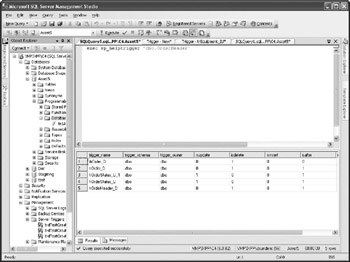Managing Triggers
You can manage triggers using GUI tools such as SQL Server Management Studio or Visual Studio, or by using Transact-SQL statements.
Managing DML Triggers in Management Studio
You can access triggers from Management Studio:
-
Expand the node of the table with which the trigger is associated.
-
Expand the trigger's node.
-
Right-click the trigger and choose Modify from the pop-up menu.
SQL Server displays a form for editing trigger properties (see Figure 9-1). This editor is very similar to the editor you use to edit stored procedures.

Figure 9-1: Managing triggers in Management Studio
To create a new trigger on the table, right-click the trigger's subnode of the table and choose New Trigger from the pop-up menu. SQL Server initially fills the form with a template for creating a new trigger.
Once you have created or modified the trigger, you can choose Assisted Editor | Check Syntax to verify it, and then File | Save to attach it to the table.
You can delete a trigger by right-clicking the trigger and choosing Delete from the pop-up menu.
Managing DDL Triggers from Management Studio
Database-level DDL triggers are managed from server | Databases | database | Programmability | Database Triggers (see Figure 9-2). Server-level DDL triggers are managed from server | Programmability | Server Triggers.
Managing Triggers Using Transact-SQL Statements
SQL Server has a rich palette of system stored procedures, functions, and views for managing triggers from Transact-SQL.

Figure 9-2: Managing database-level DDL triggers
Listing Triggers
To list triggers associated with a table, use the system stored procedure sp_helptrigger:
Exec sp_helptrigger 'dbo.OrderHeader'
The server returns the list of triggers associated with the specified table and displays the type of trigger found in the isupdate, isdelete, isinsert, isafter, and isinteadof columns (see Figure 9-3).

Figure 9-3: Trigger information from sp_helptrigger
Viewing Triggers
You can obtain the code for a trigger using the system stored procedure sp_helptext:
Exec sp_helptext 'dbo.trOrderStatus_U'
The server returns the code for the specified trigger:
Text ------------------------------------------------------------- CREATE Trigger trOrderStatus_U On dbo.[OrderHeader] After Update -- For Update As If Update (OrderStatusId) Begin Insert into ActivityLog( Activity, LogDate, UserName, Note) Select 'Order-Header.OrderStatusId' , GetDate() , USER_NAME(), 'Value changed from ' + Cast( d.OrderStatusId as varchar) + ' to ' + Cast( i.OrderStatusId as varchar) From deleted d inner join inserted i On d.OrderId = i.OrderId End
Deleting DML Triggers
A trigger can be deleted, as can all other database objects, using the appropriate Drop statement:
if exists (select * from sys.objects where object_id = object_id(N'[dbo].[trEquipment_IU]') and type in (N'TA', N'TR')) DROP TRIGGER [dbo].[trEquipment_IU]
Deleting DDL Triggers
The statement for dropping DDL triggers contains a reference to the scope (level) of the trigger:
if exists (select * from master.sys.server_triggers where name = N'trdTestCreateLogin2' and parent_class=100) DROP TRIGGER [trdTestCreateLogin2] ON ALL SERVER GO if exists (select * from sys.triggers where name = N'trdAuditTableChanges' and parent_class=0) DROP TRIGGER [trdAuditTableChanges] ON DATABASE
| Note | You should check the presence of server-level triggers in the master.sys.server_riggers view and the presence of database-level triggers in the sys.triggers view. |
Modifying Triggers
Earlier in this chapter, you saw details of the syntax of a Transact-SQL statement for creating triggers. Triggers can be modified using the Alter Trigger statement. Since the features of the Alter Trigger and Create Trigger statements are identical, we will not explore the syntax a second time.
It is much better to use the Alter Trigger statement to modify a trigger than to drop and then re-create the trigger. During the period between dropping and creating a trigger, a user might make a change to the table, the consequence of which is that the rules that are usually enforced by the trigger will not be enforced.
| Note | Keep in mind that the order of execution is lost when the trigger is altered—you must reset it using sp_SetTriggerOrder. |
Renaming Triggers
Triggers are often renamed using Transact-SQL statements designed for the creation and modification of triggers, such as Alter Trigger. As with all other database objects, a trigger can be forced to change its name using the following system stored procedure:
Exec sp_rename 'Orders_Triggerl', 'trOrders_IU'
The first parameter is the current name of the database object, and the second parameter is the new name of the object.
Disabling DML Triggers
It is possible to temporarily disable and enable triggers without dropping them:
Alter Table [OrderHeader] Disable Trigger trOrders_IU
After the execution of this statement, the specified trigger will not fire, but it will still be associated with the table. This technique is often used to load large amounts of data into a table without initiating the business logic encapsulated in a trigger.
An alternative statement has been added to SQL Server 2005 (to make it compatible with statements for DDL triggers):
DISABLE TRIGGER dbo. trOrderHeader_IU ON dbo.OrderHeader
Disabling DDL Triggers
Disable Trigger statements for DDL triggers contain a reference to trigger scope (Database or All Server):
DISABLE TRIGGER trdAuditLoginCreation ON All Server
EAN: 2147483647
Pages: 165